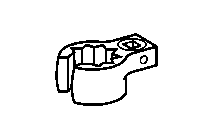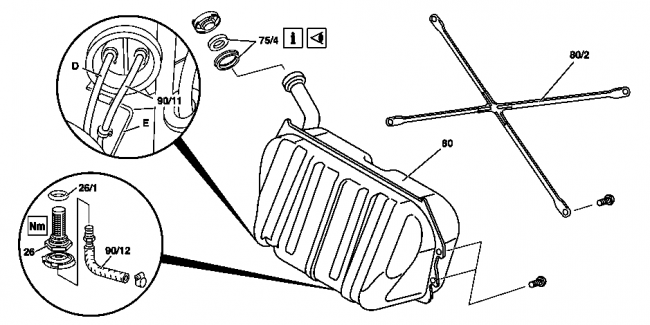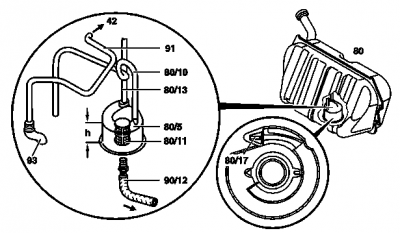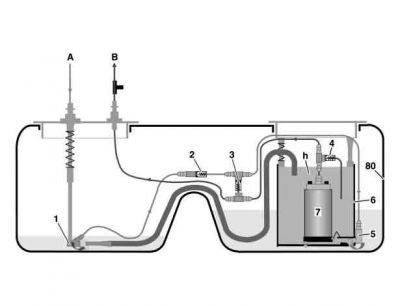Fuel tank: Difference between revisions
(fuel tank photos) |
|||
| (7 intermediate revisions by the same user not shown) | |||
| Line 1: | Line 1: | ||
== Fuel tank == | == Fuel tank == | ||
The standard fuel tank on W220 vehicles (A2204707601) has 88 liter (23 galon) volume. | |||
Vehicles with the option code [[Data Card#282 - SKI-BAG|282 (SKI-BAG)]] or [[Data Card#308 - REFRIGERATOR_IN_REAR|308 (REFRIGERATOR IN REAR)]] have the fuel tank (A2204707701) which has volume of 78 liters (20 galons). | |||
Vehicles with the option code [[Option_codes#494_-_U.S._VERSION|494 (U.S. VERSION)]] have a fuel tank pressure sensor. | |||
[[File:W220_fuel_tank_with_attachment_parts.png|thumb|none|Fuel tank with attachment parts as in [[EPC]].]] | [[File:W220_fuel_tank_with_attachment_parts.png|thumb|none|Fuel tank with attachment parts as in [[EPC]].]] | ||
| Line 16: | Line 19: | ||
|[[File:W220_A2204707701_fuel_tank_bottom.jpg|thumb|none|A2204707701 (bottom).]] | |[[File:W220_A2204707701_fuel_tank_bottom.jpg|thumb|none|A2204707701 (bottom).]] | ||
|} | |} | ||
=== Location/design/function === | |||
<!-- GF47.10-P-3000K, Fuel tank, location/design/function, 3.6.98 | |||
MODEL 220 with ENGINE 112.922 /944 /972 /975, 113.941 /948 /960 /966, 137.970 | |||
MODEL 215 with ENGINE 137.970 3.6.98 | |||
--> | |||
{| | |||
|[[File:W220_fuel_tank_location_design.png|650px]] | |||
| | |||
Shown without ski bag: | |||
* 26 - Fuel strainer | |||
* 26/1 - O-ring | |||
* 75/4 - Cup seals | |||
* 80 - Fuel tank | |||
* 80/2 - Struts securing fuel tank | |||
* 90/11 - Fuel return hose | |||
* 90/12 - Fuel hose on the suction side with Connection | |||
* D - Fuel tank-activated charcoal canister vent line (shown USA, otherwise with vent valve) | |||
* E - Air admission line for diaphragm pressure regulator in fuel filter | |||
|} | |||
The fuel tank (80) is located in the trunk above the rear axle. | |||
The fuel tank (80) is made of sheet steel. | |||
The fuel is drawn through the fuel strainer (26) in the fuel inlet hose (90/12). | |||
The fuel flows back along the return flow hose (90/11). The vent line (D) runs to the activated charcoal canister (in some cases with vent valve). | |||
== Fuel reserve == | == Fuel reserve == | ||
| Line 24: | Line 54: | ||
<!-- http://www.tankonempty.com/viewstory/2000-s500-gas-light,365 --> | <!-- http://www.tankonempty.com/viewstory/2000-s500-gas-light,365 --> | ||
The reserve is what is left when the needle is pointed all the way down to the bottom of the yellow area and the fuel warning light comes on. | The reserve is what is left when the needle is pointed all the way down to the bottom of the yellow area and the fuel warning light comes on. | ||
Hence, the fuel gauge in the instrument cluster shows the fuel level minus the reserve volume. | |||
== Splash bowl == | |||
<!-- GF47.10-P-3101C, Splash bowl, location/task/function, 22.5.96, 15.03.07 | |||
MODEL 210 with ENGINE 104, 111, 112, 113, 119, 602, 604, 605, 606, 611, 612, 613 | |||
MODEL 129 as of 1.10.95 with ENGINE 104, 112, 113, 119, 120 | |||
MODEL 140 as of 1.4.95 with ENGINE 104, 119, 120, 606 | |||
MODEL 170 with ENGINE 111 | |||
MODEL 220 with ENGINE 112, 113, 137, 613, 628 | |||
MODEL 215 with ENGINE 113, 137 | |||
MODEL 211 with ENGINE 628 | |||
--> | |||
{| | |||
| | |||
Shown on model 220: | |||
* 42 - To fuel tank ventilation system | |||
* 80 - Fuel tank | |||
* 80/5 - Splash bowl | |||
* 80/10 - Return flow line | |||
* 80/11 - Fuel strainer | |||
* 80/13 - Riser line | |||
* 80/17 - Return flow nozzle | |||
* 90/12 - Fuel suction hose | |||
* 91 - Pressurization line | |||
* 93 - Ventilation hose | |||
* h - Fuel level | |||
|[[File:W220_splash_bowl_fuel_tank.png|400px]] | |||
|} | |||
{| | |||
| | |||
Shown on model 211: | |||
* 1 - Left suction spray pump | |||
* 2 - Bleed valve | |||
* 3 - Pressure regulator valve | |||
* 4 - Pressure regulator | |||
* 5 - Right suction spray pump | |||
* 6 - Splash bowl | |||
* 7 - Fuel pump in swirl pot | |||
* 80 - Fuel tank | |||
* A - Return flow | |||
* B - Feed line to engine | |||
* h - Fuel level | |||
|[[File:W220_splash_bowl_fuel_tank_from_side.jpg|400px]] | |||
|} | |||
The swirl pot is mounted in the fuel tank. | |||
The task of the splash bowl is supplying the engine with fuel in the event of a low fuel level in the fuel tank and during lengthy cornering. | |||
The fuel return flow stream flows out of the return flow nozzle (80/17) into the splash bolw at a high velocity when the fuel pump | |||
is operated. As a result, the fuel around the return flow nozzle (80/17) is also entrained and carried into the splash bowl. | |||
== Fuel level sensor == | |||
<!-- GF47.10-P-3001B, Fuel level sensor, location/task/design/function, 18.3.08 | |||
MODEL 210 with ENGINES 104, 111, 112, 113, 119, 602, 604, 605, 606, 611, 612, 613 | |||
MODEL 129 as of 1.10.95 with ENGINES 104, 112, 113, 119, 120 | |||
MODEL 140 as of 1.4.95 with ENGINE 104, 119, 120, 606 | |||
MODEL 170 with ENGINE 111, 112 | |||
MODEL 220 with ENGINE 112, 113, 137, 275, 613, 628 (except , 113.99) | |||
MODEL 215 with ENGINE 113, 137, 275 (except 113.99) | |||
MODEL 230 with ENGINE 112, 113, 275 (except , 113.99) up to Model Year 08 /AEJ 07 | |||
MODEL 240 with ENGINE 285 | |||
--> | |||
{| | |||
|[[File:W220_fuel_gauge_level_sensor.png|350px]] | |||
| | |||
* 89/1 - Lever-type sensor | |||
* 89/2 - Potentiometer | |||
* 89/3 - Sliding contacts | |||
* B4 - Fuel level indicator sensor (except model 140) | |||
|} | |||
The fuel level indicator sensor (''also known as fuel gauge'') is installed in the fuel tank via a bayonet latch. | |||
The task of the sensor is determining the fuel level in the fuel tank. | |||
The fuel level sensor (B4) is a lever-type sensor with sliding contacts (potentiometer). | |||
The resistance of the fuel gage sensor (B4) is analyzed in the electronics of the fuel gage. | |||
Example model 208: Low resistance = Fuel tank empty, High resistance = Fuel tank full. | |||
In the event of a open circuit the fuel gauge in the instrument cluster indicates empty. The fuel reserve warning lamp (A1e4) does not light up. | |||
== Fuel tank pressure sensor (version USA) == | |||
<!-- GF47.30-P-4032L, Fuel tank pressure sensor location/task/function, 10.7.96 | |||
MODEL 129 with ENGINE 104.943 /991 as of 1.8.96, 112.923 /943, 113.961, 119.982, 120.983 with CODE (494) USA version | |||
MODEL 140 with ENGINE 104.944 /994 as of 1.8.96, 119.981 /980, 120.982 with CODE (494) USA version | |||
MODEL 163 with ENGINE 112.942 /970, 113.942 /965 with CODE (494) USA version | |||
MODEL 170 with ENGINE 111.943 /973 /983, 112.947 with CODE (494) USA version | |||
MODEL 202 with ENGINE 104.941 as of 1.8.96, 111.921 as of 1.9.98, 111.974, 111.975 as of 1.8.96, 111.944 /945, 112.910 /920 with CODE (494) USA version | |||
MODEL 203 with ENGINE 111.951 /955, 112.912 /916 /946 /953 with CODE (494) USA version up to Model Year 8 | |||
MODEL 208 with ENGINE 111.944 /945 /975, 112.940, 113.943 with CODE (494) USA version | |||
MODEL 209 with ENGINE 112.912 /955, 113.968 with CODE (494) USA version | |||
MODEL 210 with ENGINE 104.995, 111.942 as of 1.9.98, 111.947, 112.911 /914 /921 /941, 113.940, 119.985 /980 with CODE (494) USA version | |||
MODEL 215 with ENGINE 113.960, 137.970 with CODE (494) USA version | |||
MODEL 220 with ENGINE 112.922 /944 /972 /975, 113.941 /948 /960 /966, 137.970 with CODE (494) USA version | |||
MODEL 230 with ENGINE 112.973, 113.963 with CODE (494) USA version up to Model Year 8 | |||
MODEL 211 with ENGINE 112.913 /917 /949 /954, 113.967 /969 with CODE (494) USA version | |||
--> | |||
{| | |||
|[[File:W220_fuel_tank_pressure_sensor.png|400px]] | |||
| | |||
Shown on model 210: | |||
* B4 - Fuel gage sensor | |||
* B4/3 - Fuel tank pressure sensor | |||
|} | |||
''The fuel tank pressure sensor is built into the hausing of the fuel gauge.'' | |||
The task for the fuel tank pressure sensor is detecting the internal pressure of the fuel tank for the leak test of the fuel system. | |||
The output signal depends on the pressure inside the tank and is transmitted to the engine control unit. | |||
== Remove/install fuel tank == | |||
<!-- AR47.10-P-4100IA, Remove/install fuel tank, 23.11.09 | |||
MODEL 215.373 /374 /375 /376 /378 /379, 220.026 /028 /063 /065 /067 /070 /073 /074 /075 /083 /084 /087 /128 /165 /167 | |||
/170 /173 /174 /175 /179 /183 /184 /187 /875 /878 | |||
except CODE (282) Ski bag (through-loading feature) | |||
except CODE (308) Cooling compartment in center rear backrest | |||
--> | |||
{| | |||
|[[File:W220_fuel_tank_location_design.png|650px]] | |||
| | |||
Shown on fuel tank model 220: | |||
* 26 - Fuel strainer | |||
* 26/1 - O-ring | |||
* 75/4 - Cup seals | |||
* 76/1 - Vent line (diesel engine) | |||
* 80 - Fuel tank | |||
* 80/2 - Struts securing fuel tank | |||
* 90/11 - Fuel return hose | |||
* 90/12 - Fuel hose on the suction side with Connection fitting | |||
* D - Fuel tank - activated charcoal canister line (gasoline engine) | |||
* E - Fuel filter - fuel tank degassing line (gasoline engine) | |||
|} | |||
<!-- AR47.10-P-4100I, Remove/install fuel tank, 23.11.09 | |||
MODEL 215.375 /376 /378 /379, 220.026 /028 /128 /063 /065 /067 /083 /084 /087 /165 /167 /070 /170 /075 /175 /176 /179 /183 /184 /187 /875 /878 | |||
with CODE (282) Ski bag (through-loading feature) | |||
with CODE (308) Cooling compartment in center rear backrest | |||
--> | |||
{| | |||
||[[File:W220_fuel_tank_location_design_skibag.png|650px]] | |||
| | |||
Shown on fuel tank model 220 with option code [[Option codes#282 - SKI-BAG|282 (SKI-BAG)]] or [[Option codes#308 - REFRIGERATOR_IN_REAR|308 (REFRIGERATOR IN REAR)]]: | |||
* 26 - Fuel strainer | |||
* 26/1 - O-ring | |||
* 75/4 - Cup seals | |||
* 76/1 - Vent line (diesel engine) | |||
* 80 - Fuel tank | |||
* 80/1 - Rear wall of fuel tank | |||
* 80/23 - Mounting rails | |||
* 90/11 - Fuel return hose | |||
* 90/12 - Fuel hose on the suction side with connection fitting | |||
* D - Fuel tank - activated charcoal canister line (gasoline engine) | |||
* E - Fuel filter - fuel tank degassing line (gasoline engine) | |||
|} | |||
# Drain fuel tank (80). Pay attention to fuel quantity. | |||
# Remove trim panel in trunk | |||
# With option code [[Option codes#282 - SKI-BAG|282 (SKI-BAG)]] or [[Option codes#308 - REFRIGERATOR_IN_REAR|308 (REFRIGERATOR IN REAR)]]: Remove rear wall of fuel tank (80/1) | |||
# With option code [[Option codes#282 - SKI-BAG|282 (SKI-BAG)]] or [[Option codes#308 - REFRIGERATOR_IN_REAR|308 (REFRIGERATOR IN REAR)]]: Detach lower mounting rails (80/23) of fuel tank rear wall (80/1) from trunk floor. Do not detach upper mounting rails (80/23) at rear shelf. | |||
# With option code [[Option codes#282 - SKI-BAG|282 (SKI-BAG)]] or [[Option codes#308 - REFRIGERATOR_IN_REAR|308 (REFRIGERATOR IN REAR)]]: Take spare tire out of spare tire well | |||
# Without option code [[Option codes#282 - SKI-BAG|282 (SKI-BAG)]] or [[Option codes#308 - REFRIGERATOR_IN_REAR|308 (REFRIGERATOR IN REAR)]]: Detach mounting struts (80/2) of fuel tank (80) | |||
# Raise vehicle | |||
# Vehicles with gasoline engine: Detach fuel hose on the suction side with connection fitting (90/12), fuel return hose (90/11), and fuel tank - activated charcoal canister line (gasoline engine). Do not damage fuel filter - fuel tank degassing line (gasoline engine) (E). Collect remaining fuel, seal connections. | |||
# Vehicles with diesel engine: Detach fuel hose on the suction side connection fitting (90/12), fuel return hose (90/11) and vent line (76/1). Collect remaining fuel, seal connections. Box wrench bit W000589710300. | |||
# Take out fuel tank (80). Inspect whether cup seals (75/4) can be re-used. | |||
# Check sound deadening mat for damage | |||
# Remove fuel strainer (26). Clean and check for re-usability. The splash bowl in the fuel tank is secured against turning with 2 pins. It is attached together with the fuel strainer (26). | |||
# Replace O-ring (26/1). Installation: Oil to facilitate installation. | |||
# Install in the reverse order | |||
Torque specifications: | |||
* Fuel strainer in fuel tank: 40 Nm | |||
* Fuel hose with connection fitting on fuel strainer: 30 Nm | |||
[[File:W220_box_wrench_bit_W000589710300.png|thumb|none|Box wrench bit W000589710300]] | |||
Latest revision as of 18:57, 29 September 2021
Fuel tank
The standard fuel tank on W220 vehicles (A2204707601) has 88 liter (23 galon) volume. Vehicles with the option code 282 (SKI-BAG) or 308 (REFRIGERATOR IN REAR) have the fuel tank (A2204707701) which has volume of 78 liters (20 galons).
Vehicles with the option code 494 (U.S. VERSION) have a fuel tank pressure sensor.
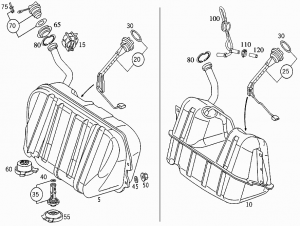
Fuel tank (88l)
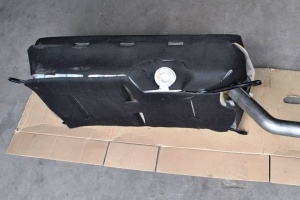 |
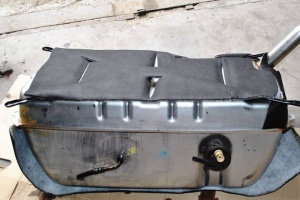 |
Fuel tank (78l)
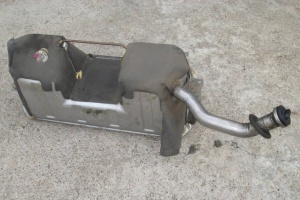 |
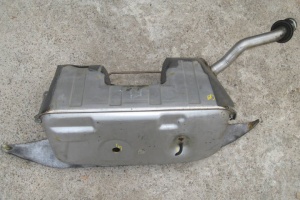 |
Location/design/function
The fuel tank (80) is located in the trunk above the rear axle. The fuel tank (80) is made of sheet steel.
The fuel is drawn through the fuel strainer (26) in the fuel inlet hose (90/12). The fuel flows back along the return flow hose (90/11). The vent line (D) runs to the activated charcoal canister (in some cases with vent valve).
Fuel reserve
The 88 liter tank uses 11 liters as a reserve. The 78 liter tank uses 10 liters as a reserve.
The reserve is what is left when the needle is pointed all the way down to the bottom of the yellow area and the fuel warning light comes on. Hence, the fuel gauge in the instrument cluster shows the fuel level minus the reserve volume.
Splash bowl
The swirl pot is mounted in the fuel tank. The task of the splash bowl is supplying the engine with fuel in the event of a low fuel level in the fuel tank and during lengthy cornering.
The fuel return flow stream flows out of the return flow nozzle (80/17) into the splash bolw at a high velocity when the fuel pump is operated. As a result, the fuel around the return flow nozzle (80/17) is also entrained and carried into the splash bowl.
Fuel level sensor
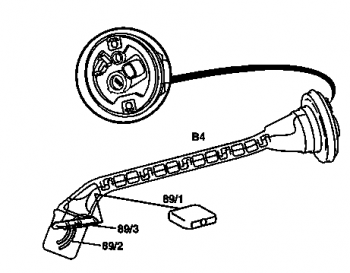
|
|
The fuel level indicator sensor (also known as fuel gauge) is installed in the fuel tank via a bayonet latch.
The task of the sensor is determining the fuel level in the fuel tank. The fuel level sensor (B4) is a lever-type sensor with sliding contacts (potentiometer).
The resistance of the fuel gage sensor (B4) is analyzed in the electronics of the fuel gage. Example model 208: Low resistance = Fuel tank empty, High resistance = Fuel tank full. In the event of a open circuit the fuel gauge in the instrument cluster indicates empty. The fuel reserve warning lamp (A1e4) does not light up.
Fuel tank pressure sensor (version USA)
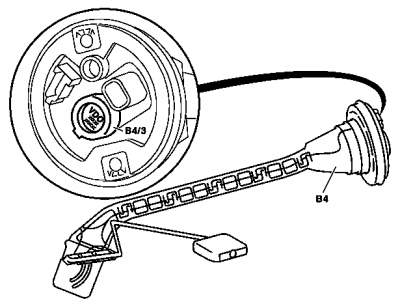
|
Shown on model 210:
|
The fuel tank pressure sensor is built into the hausing of the fuel gauge.
The task for the fuel tank pressure sensor is detecting the internal pressure of the fuel tank for the leak test of the fuel system.
The output signal depends on the pressure inside the tank and is transmitted to the engine control unit.
Remove/install fuel tank

|
Shown on fuel tank model 220 with option code 282 (SKI-BAG) or 308 (REFRIGERATOR IN REAR):
|
- Drain fuel tank (80). Pay attention to fuel quantity.
- Remove trim panel in trunk
- With option code 282 (SKI-BAG) or 308 (REFRIGERATOR IN REAR): Remove rear wall of fuel tank (80/1)
- With option code 282 (SKI-BAG) or 308 (REFRIGERATOR IN REAR): Detach lower mounting rails (80/23) of fuel tank rear wall (80/1) from trunk floor. Do not detach upper mounting rails (80/23) at rear shelf.
- With option code 282 (SKI-BAG) or 308 (REFRIGERATOR IN REAR): Take spare tire out of spare tire well
- Without option code 282 (SKI-BAG) or 308 (REFRIGERATOR IN REAR): Detach mounting struts (80/2) of fuel tank (80)
- Raise vehicle
- Vehicles with gasoline engine: Detach fuel hose on the suction side with connection fitting (90/12), fuel return hose (90/11), and fuel tank - activated charcoal canister line (gasoline engine). Do not damage fuel filter - fuel tank degassing line (gasoline engine) (E). Collect remaining fuel, seal connections.
- Vehicles with diesel engine: Detach fuel hose on the suction side connection fitting (90/12), fuel return hose (90/11) and vent line (76/1). Collect remaining fuel, seal connections. Box wrench bit W000589710300.
- Take out fuel tank (80). Inspect whether cup seals (75/4) can be re-used.
- Check sound deadening mat for damage
- Remove fuel strainer (26). Clean and check for re-usability. The splash bowl in the fuel tank is secured against turning with 2 pins. It is attached together with the fuel strainer (26).
- Replace O-ring (26/1). Installation: Oil to facilitate installation.
- Install in the reverse order
Torque specifications:
- Fuel strainer in fuel tank: 40 Nm
- Fuel hose with connection fitting on fuel strainer: 30 Nm
